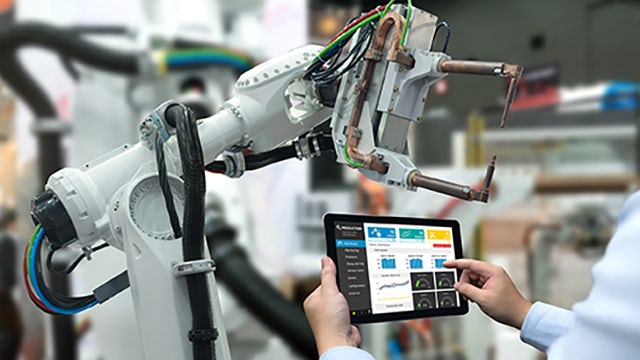Witamy w Twojej cyfrowej przyszłości
Twoja cyfrowa transformacja zaczyna się od oprogramowania jako usługi (SaaS). Opracowuj innowacje bez żadnych ograniczeń, przyznając zespołowi dostęp do niezbędnych funkcji na żądanie. Dowiedz się więcej o Siemens Xcelerator i odwiedź nasz blog Siemens Xcelerator Software dla branży, aby dowiedzieć się więcej o naszych usługach w chmurze.
Przyspiesz transformację cyfrową przedsiębiorstwa
Siemens Xcelerator to kompleksowe, zintegrowane portfolio oprogramowania, usług i platformy do tworzenia aplikacji, ułatwiających przedsiębiorstwom zrealizowanie transformacji cyfrowej. Te oparte na chmurze narzędzia są udostępniane w postaci rozwiązania Siemens Xcelerator oferowanego jako usługa z myślą o przyspieszeniu transformacji cyfrowej
Elastyczność
Zwiększ możliwości zespołów, niezależnie od zakresu projektu, dzięki platformie ułatwiającej współpracę na żądanie i bezpiecznie łączącej dane między domenami i rozwiązaniami inżynieryjnymi. Możliwość korzystania z zaawansowanego oprogramowania zapewnia prawdziwą swobodę rozwoju innowacji.
Dostępność
Firmy każdej wielkości mogą uzyskać dostęp do potrzebnych narzędzi i kiedy ich potrzebują, dzięki czemu zespoły pracują z jednego źródła prawdy z dowolnego miejsca i w dowolnym czasie. Dostępność pozwala wyeliminować silosy informacyjne i zwiększyć efektywność pracy.
Skalowanie
Nasze rozwiązania chmurowe w modelu SaaS umożliwiają przedsiębiorstwom z różnych branż i rynków szybkie skalowanie i dostosowywanie się do dynamicznych środowisk biznesowych. Szybko i ekonomicznie wdrażaj nowe technologie w zależności od potrzeb.
Uzyskaj dostęp do możliwości rozwiązania Siemens Xcelerator oferowanego jako usługa
Dzięki rozwiązaniu Siemens Xcelerator oferowanemu jako usługa można sprawniej projektować produkty, szybciej wprowadzać je na rynek i optymalizować wraz z każdą iteracją.
Niezależnie od wielkości firmy i branży, możesz wykorzystać naszą zaawansowaną, opartą na chmurze technologię, zarówno w siedzibie firmy, jak i poza nią, aby przekształcić inspirację w innowację.
Zwiększ produktywność dzięki aplikacjom branżowym SaaS
Uzyskuj dostęp do naszych elastycznych, specjalnie zaprojektowanych, natywnych dla chmury aplikacji w dowolnym miejscu i czasie. Małe i średnie przedsiębiorstwa mogą teraz skalować swoje możliwości, współpracować i zwiększać produktywność działania wszystkich zespołów oraz obsługi dostawców i klientów dzięki łatwemu w użyciu oprogramowaniu do obsługi produkcji w chmurze, obejmującemu rozwiązania inżynieryjne od podstawowych do wysoce złożonych.

Zobacz produkty Siemens Xcelerator
Realizuj wiele modeli przetwarzania w chmurze i wdrażania oprogramowania, korzystając z naszej znanej na całym świecie oferty oprogramowania dostępnego w chmurze. Nasza oferta gotowa do pracy w chmurze obsługuje różnych klientów przemysłowych i komercyjnych oraz umożliwia dedykowanym zespołom tworzenie i skalowanie w tempie, które łatwo odpowiada ich celom biznesowym i zadaniom za pośrednictwem aplikacji SaaS.

Dostęp przez chmurę, zawsze i wszędzie
Co to znaczy być połączonym z chmurą? Twój zespół zyskuje natychmiastowy dostęp z dowolnego miejsca i o każdej porze, przez przeglądarkę internetową. Uzyskaj dostęp do danych w czasie rzeczywistym oraz uruchamiaj, testuj i symuluj złożone wyzwania przemysłowe. Lepiej wykorzystaj naszego wszechstronnego cyfrowego bliźniaka i ciesz się najnowszym oprogramowaniem i ofertą bezpieczeństwa danych. Amazon Web Services (AWS), nasz partner, oferuje różnorodne rozwiązania firmy Siemens połączone z chmurą.

Transformacja cyfrowa: co mówią eksperci?
Posłuchaj, co mówią eksperci o rozwiązaniu Siemens Xcelerator Cloud i korzyściach zapewnianych przez model SaaS, przetwarzanie w chmurze oraz wdrażaniu najlepszego oprogramowania do zarządzania chmurą i praktyk cyfrowych w każdym przedsiębiorstwie.
Lista odtwarzania wideo Siemens Xcelerator
1 / 7
Lista odtwarzania wideo Siemens Xcelerator
1 / 7
Odwiedź stronę poświęconą partnerstwu firm Siemens i AWS
Dzięki partnerstwu firm Siemens i AWS transformacja cyfrowa jest teraz bardziej dostępna, elastyczna i skalowalna. Współpraca między wiodącym producentem oprogramowania przemysłowego i dostawcą usług w chmurze odgrywa kluczową rolę dla wielu klientów z różnych branż decydujących się na digitalizację swoich firm.
Odkryj, w jaki sposób rozwiązanie Siemens Xcelerator oferowane jako usługa oferuje zespołom swobodę działania i bezgraniczną kreatywność.

Dowiedz się, co ta najlepsza w swojej klasie technologia może dla Ciebie zrobić
Przekształć się dzięki najlepszej w swojej klasie technologii sztucznej inteligencji (AI) i uczenia maszynowego (ML), ofertom w chmurze automatyzacji projektowania elektronicznego (EDA), przemysłowemu internetowi rzeczy (IIoT) i możliwościom platformy aplikacji niskokodowych.
Każda firma z każdej branży może skorzystać z naszej zaawansowanej technologii.











